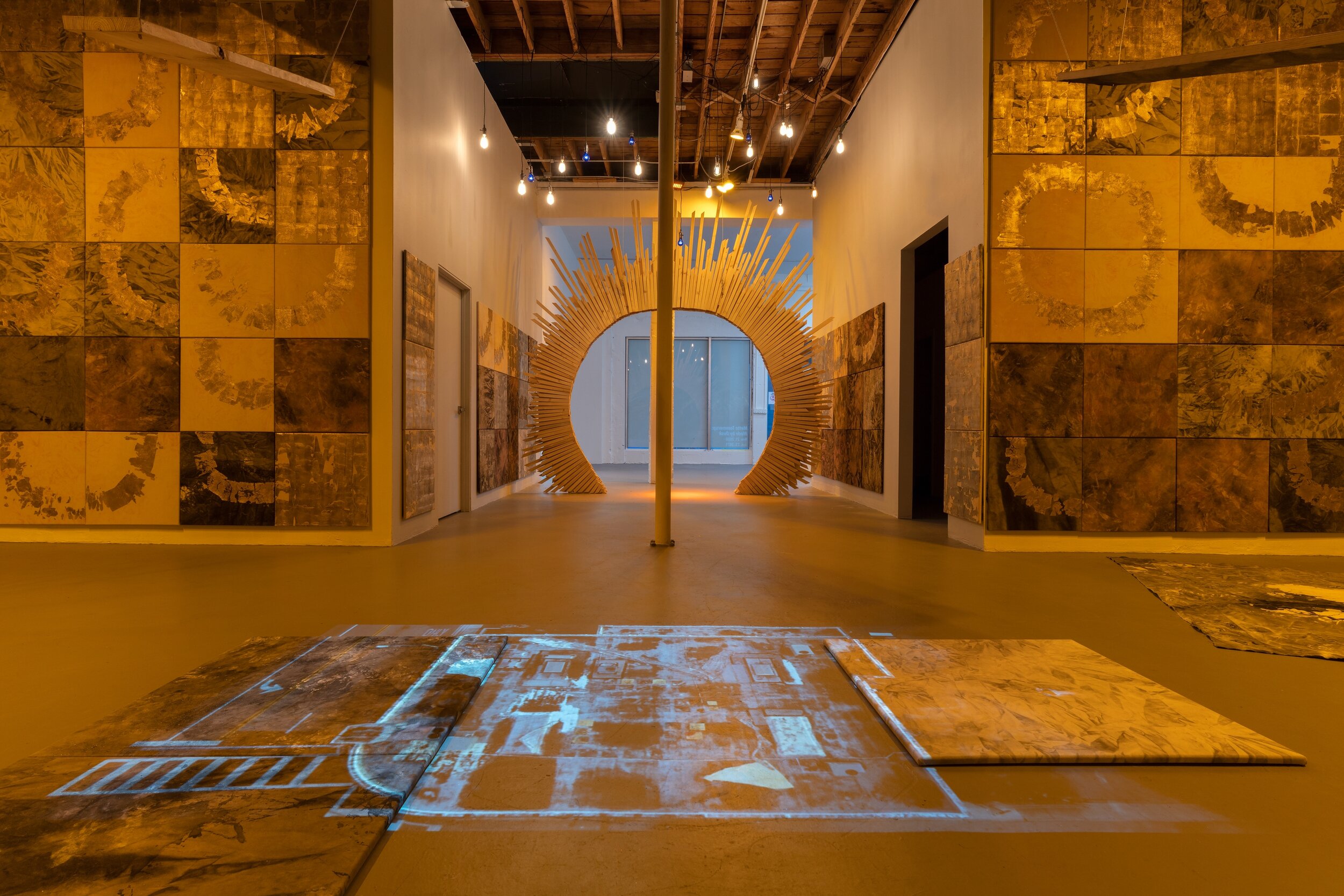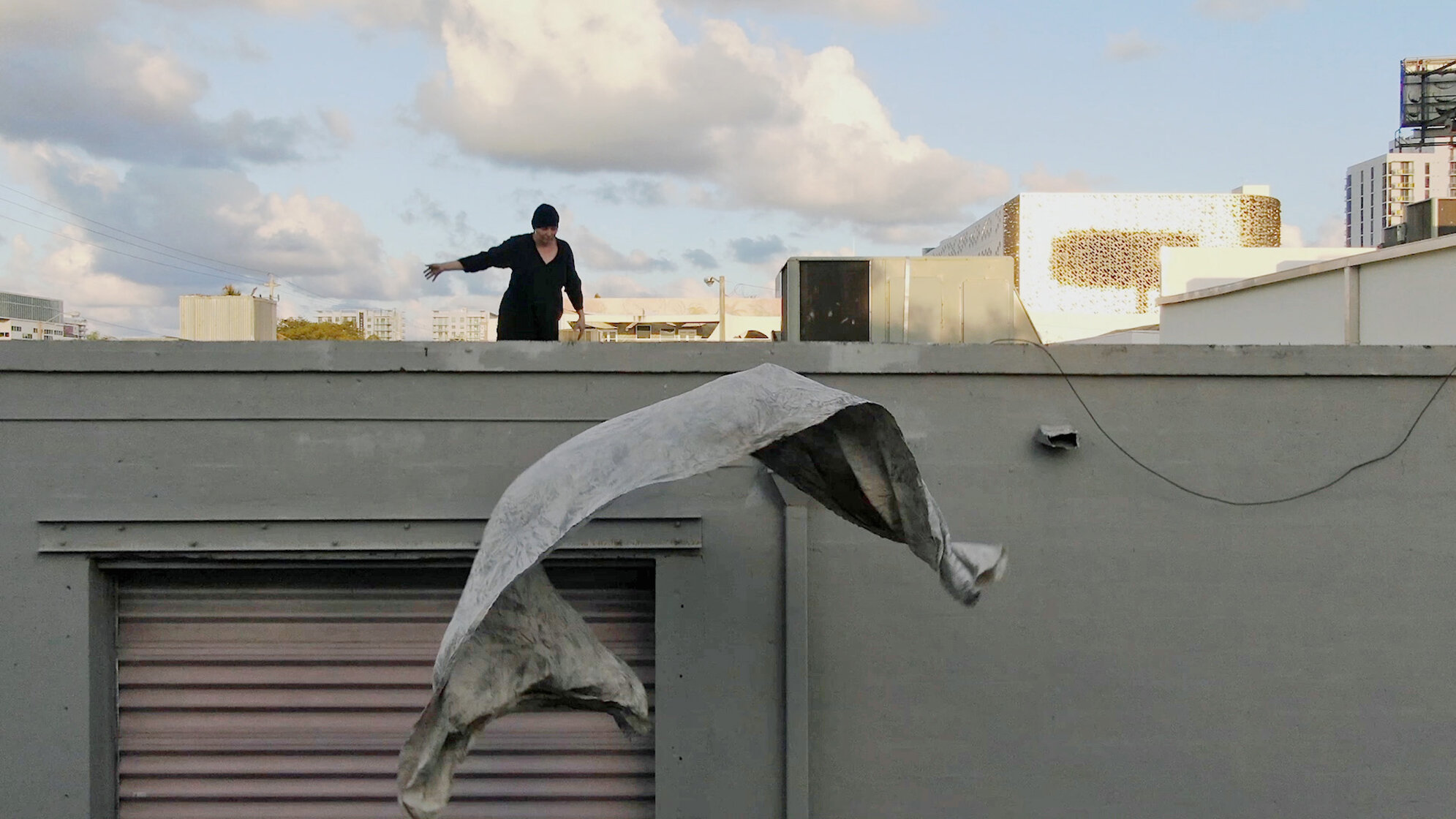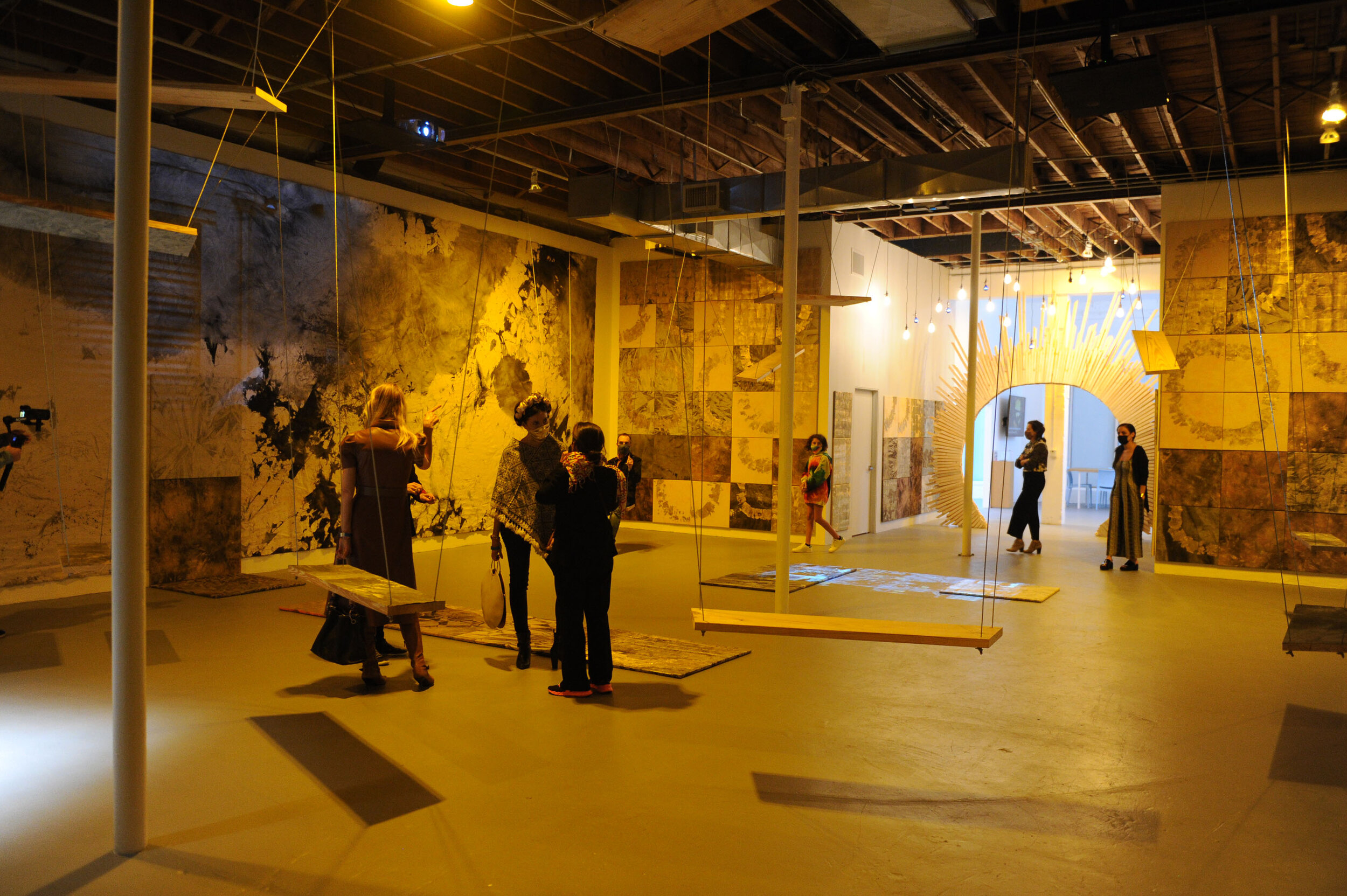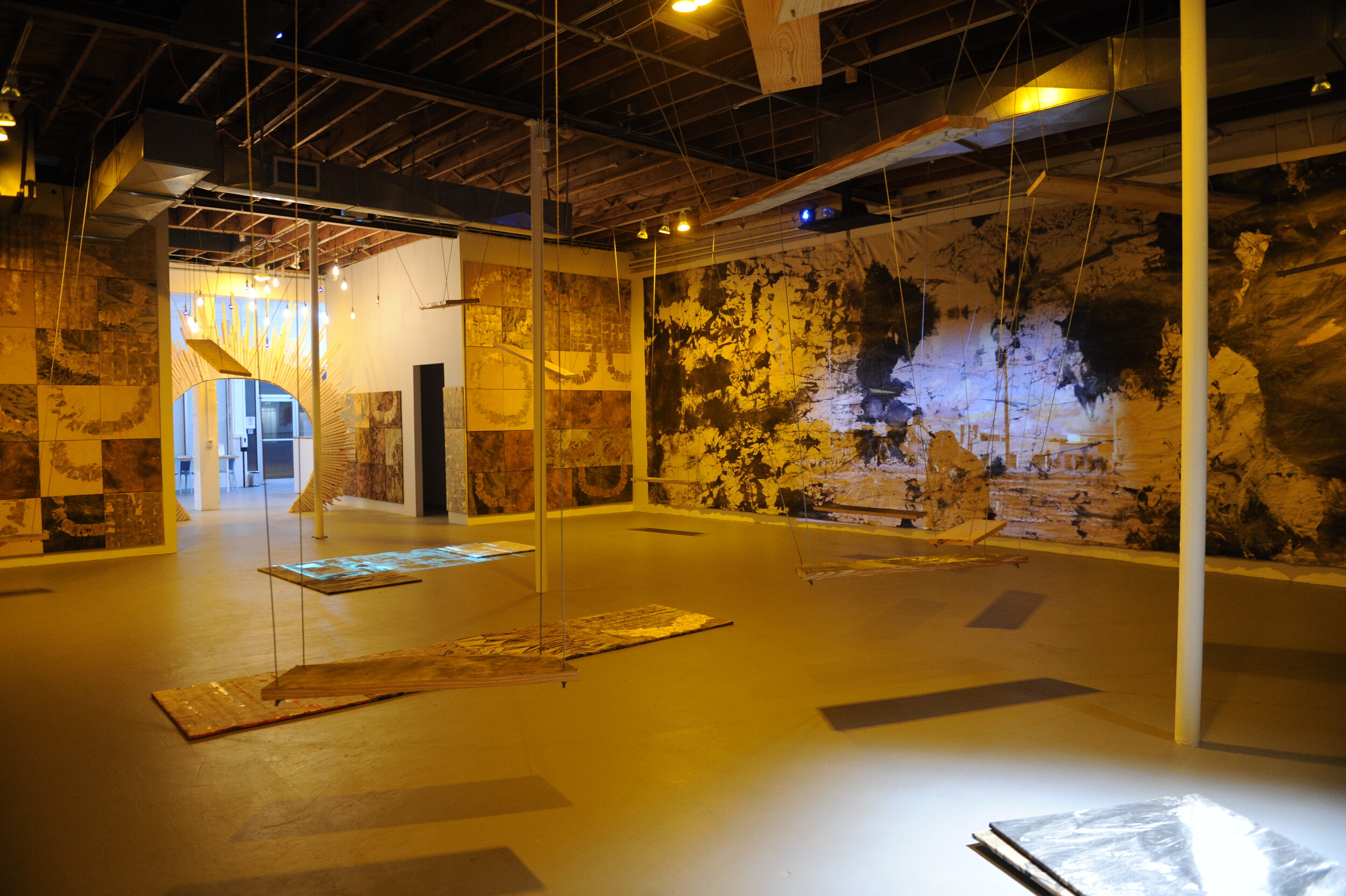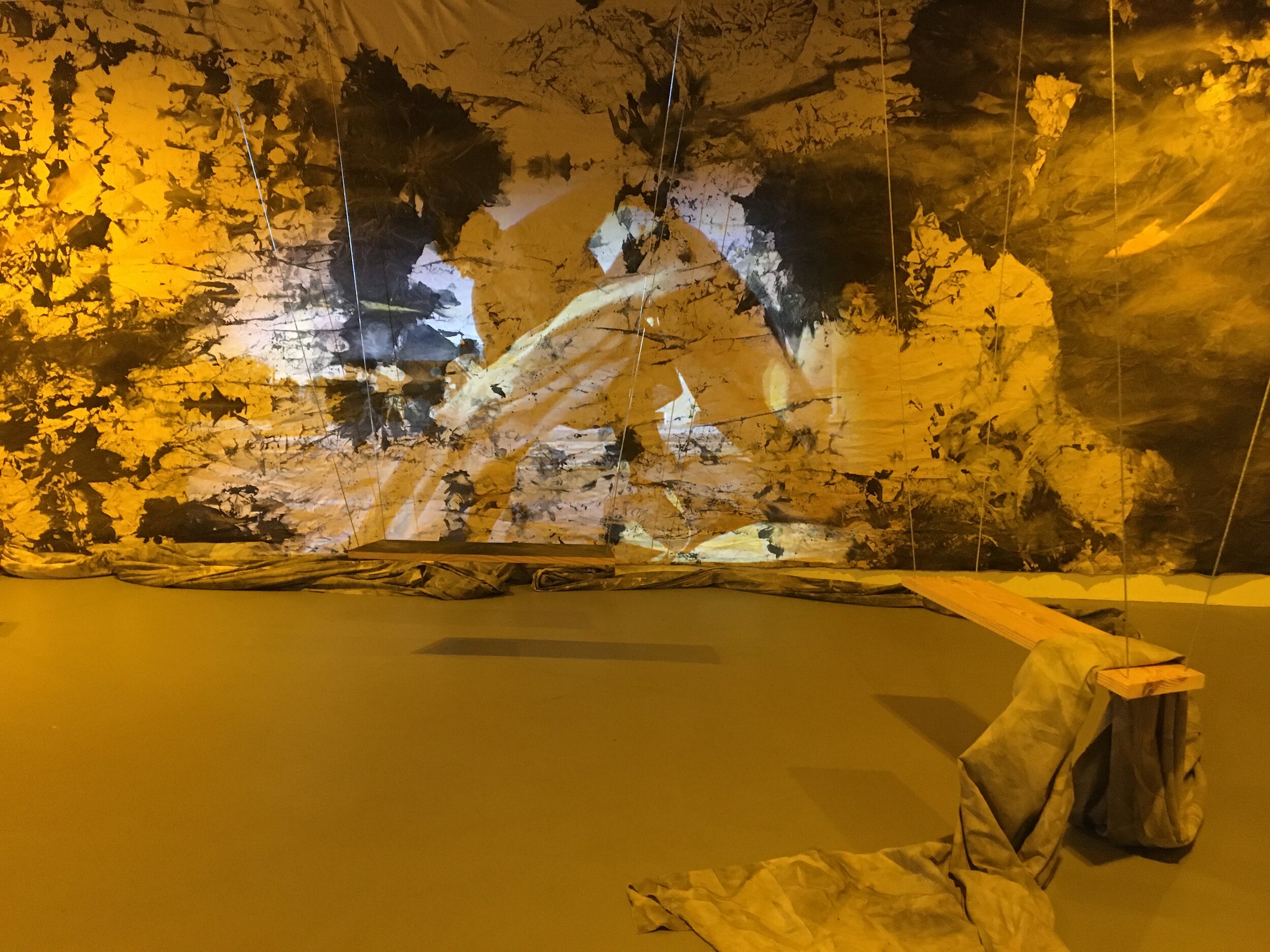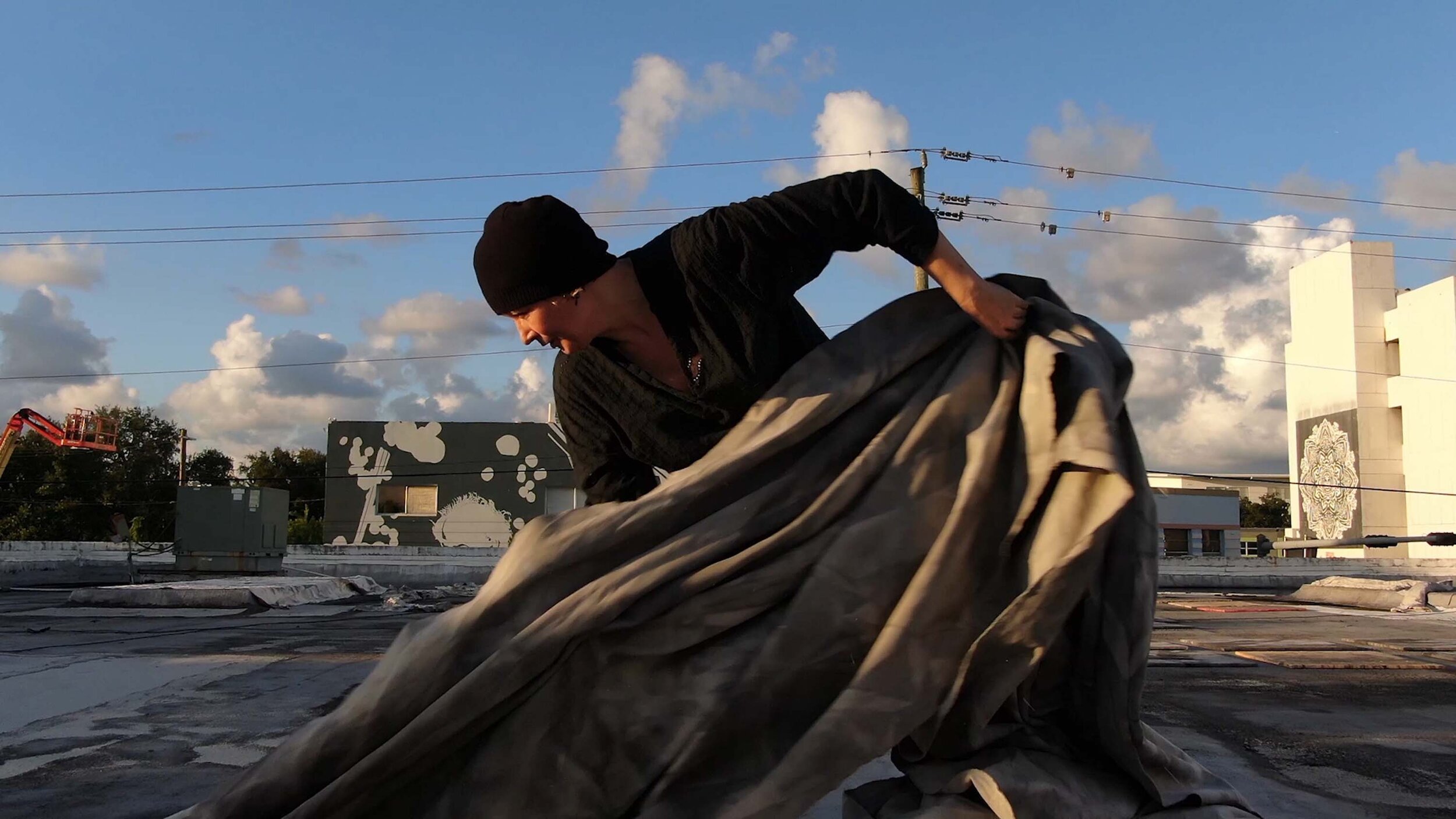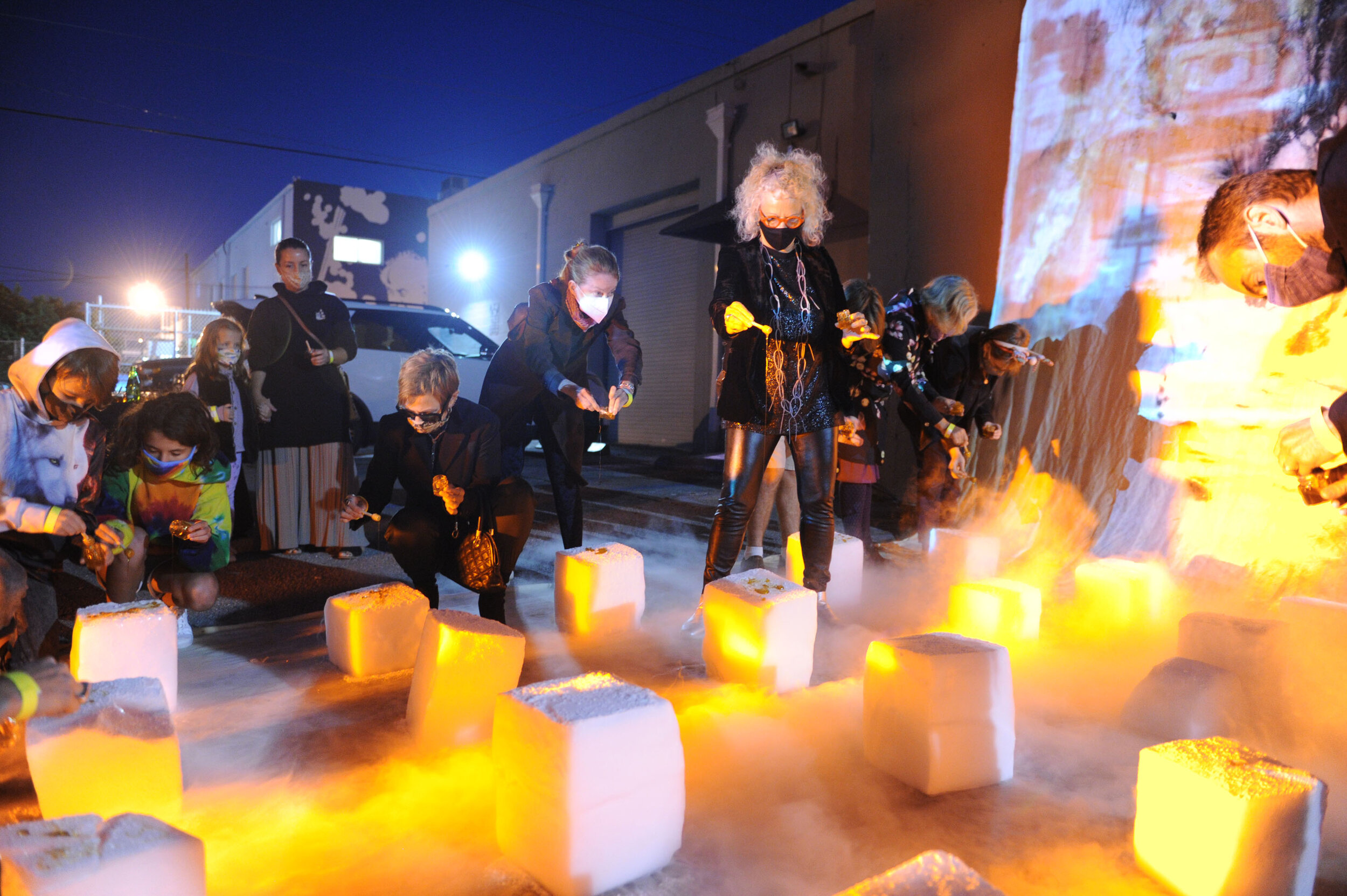Mette Tommerup: Made by Dusk | By Eleanor Heartney
H. G. Wells called dusk “the great pause,” that moment when time seems to stop and the possibilities of day melt into the stillness of the night. In many traditional cultures, dusk is the time when beings from other realms steal forth – among them ghosts, fairies, spirits and demons. In the chronology of human life, dusk is often associated with death. But it can also be seen as a prelude to transformation and rebirth.
Mette Tommerup’s Made by Dusk is an immersive installation that evokes the multiple meanings of this magical time of day. The work’s presiding spirit is Freya, the Nordic goddess of love, beauty, war, gold and magic who holds court in Sessrúmnir, a great hall populated with the spirits of fallen soldiers. This bellicose setting is here reworked to evoke a more feminine and womblike place of refuge where visitors can avail themselves of the healing potential of the great pause.
Made by Dusk is the third and final work in a trilogy of installations in which Tommerup explores art’s ability to provide experiences of reflection, connection and restoration. In this quest, she returns continually to antecedents in the historical avant garde. She gravitates toward movements and artists that share her desire to replace ossified conventions of thought and perception with new modes of consciousness. Tommerup’s Ocean Loop from 2018 drew on postwar movements like Gutai, Arte Povera and Conceptual Art. Her 2019 installation Love, Ur resonated with Happenings, Fluxus and other participatory experiments of the 1960s and 70s. Made by Dusk, meanwhile, connects with modernism’s visionary side.
The installation opens in a gallery filled with flickering lights and shadows cast from suspended benches. This area is the antechamber to the Great Hall, a room lined with tapestries. These provide the backdrop for a modernist version of Freya’s throne, here transformed into an airy constructivist seating area. The tapestries are composed of canvases to which pigment and gold leaf have been applied in various ways. These provide continuity with the other installations in the trilogy. In Ocean Loop individual canvases were scattered around the gallery walls to create a mosaic of oceanic experiences. In Love, Ur, they were wrapped around columns and draped across walls to encourage viewer interaction. Here canvases take the form of glittering wall hangings in the antechamber and of a massive quilt glowing with luminous shades of gray and gold in the open hall.
“This bellicose setting is here reworked to evoke a more feminine and womblike place of refuge where visitors can avail themselves of the healing potential of the great pause.”
These tapestries are part of Tommerup’s efforts to rethink the nature of painting. In all three installations she has explored various brushless methods of applying pigment to canvas. These include literally drowning her paintings in the sea, burying them in the earth, folding and crushing them to create serendipitous pigment patterns and allowing them to be stained by the elements. Such processes transform the canvases into records of larger external forces. Tommerup resists the idea that a painting is an isolated discrete object. Instead, she envisions her canvases as elements in a larger entity comprised, in the words of Italian critic Germano Celant, of “a continuous surface existing in time ad infinitum.”
The central seating area that is framed by these canvases exists within an equally complex web of references and associations. It is composed of wood and cables strung together to create a floating kite-like structure. The form of the amphitheater is based on the principle of tensegrity. As discovered by sculptor Kenneth Snelson and adopted by futurist Buckminster Fuller, tensegrity produces structure through dynamic equilibrium. Compression tubes connected by tension cables create modular forms that hold their shape even in the absence of gravity. Snelson used to remark that a tensegrity structure would hold its form in outer space.
Snelson used tensegrity to create sculptures that suggested towers, cantilevers, arches and other less referential forms that seem to defy the laws of gravity. His steel tubes appear suspended like a cluster of pick-up sticks cast into the air and frozen in place by the thin cables. Tommerup uses the principle of tensegrity to give her throne room a sense of infinity. The modular forms feel like they could be extended in all directions. They rise above the ground in apparent defiance of gravity, an apt metaphor for the goddess Freya who presides over a world suspended between earth and heaven.
“Tommerup envisions her canvases as elements in a larger entity comprised, in the words of Italian critic Germano Celant, of ‘a continuous surface existing in time ad infinitum.’”
Modernist art, especially in its minimalist and geometric aspects, was construed by critics like Clement Greenberg as an expression of pure form stripped of all narrative, mythological and metaphorical aspects. But in fact, no form is “pure” in that sense. Artists and architects have always recognized that structure can be read as metaphor. Snelson used tensegrity to suggest all kinds of playful organic and architectural forms. Buckminster Fuller took the idea and applied it to practical structures that expressed his vision of a future utopian society. Conceptual artist Agnes Denes envisions modular pyramids as models for a society in which tiny individuals together compose a collective whole. She has designed a series of dynamic open fretted pyramids that could provide a future society with ecologically self-sustained housing in outer space. Such ideas resonate with the work of artist Will Insley who was Tommerup’s thesis advisor when she was a student at the School of Visual Arts in New York City. Insley spent fifty years conceptualizing labyrinthine structures for a visionary city, entitled, ONECITY that he described as a mythological space existing in some undetermined time.
Like these artists, Tommerup marries myth and modernism in the belief that art can help us reimagine possible futures. Made by Dusk appears on the 100th anniversary of women’s right to vote. Transforming Freya’s hall of the dead into a space for connection and contemplation, she honors a female sensibility that prizes communion over division, reverence for nature over domination, empathy over individualism and life over death. She cites another influence on her thinking, a 1977 work by Joseph Beuys titled Honey Pump that presented a physical representation of what we now call the “hive mind.” In this work, two tons of liquid honey were pumped by a motor through a series of tubes that connected all the rooms of a museum. Another metaphor, Honey Pump celebrated the communal social order of bees as an alternative to our atomized and disconnected reality.
Made by Dusk is also designed to break the barriers that separate human from human, past from future and myth from science. With this work, Tommerup encourages us to take advantage of our own current “great pause” to reconsider meaning and purpose in this deeply unsettling time.
“With this work, Tommerup encourages us to take advantage of our own current “great pause” to reconsider meaning and purpose in this deeply unsettling time.”
About Liminal
On an unusually brisk night in Miami’s Design District, Locust Projects kicked off its Miami Art Week events with Liminal, an outdoor performance by Miami-based artist Mette Tommerup presented in conjunction with her exhibition Made by Dusk. Viewed from the parking lot behind Locust Projects starting at twilight, the performance included video projections on a massive canvas streaming down from the roof covering a portion of the parking lot upon which were placed blocks of dry ice. Attendees were invited to make a symbolic offering to the Nordic Goddess Freya by dripping honey from small jars onto the individual cubes, creating a hazy fog through sublimation that captured the light, enveloping all in a warm, golden glow. The artist appeared from her position on the roof at various intervals during the four 30-minute performances, at times laboriously pulling and lowering massive canvases and, at others, casting a stream of golden flowers across the scene below. Ambient ethereal sounds by artist-composer, Dave Brieske, filled the night air as attendees’ honeyed wishes and desires were cast heavenward.
ABOUT THE ARTIST
Mette Tommerup (born Denmark 1969) is a painter and storyteller who creates simultaneously earnest and satirical narratives to frame her production of objects, whether they are digital or made from canvas and paint. Tommerup has exhibited at The Bass, Perez Art Museum Miami (PAMM) and The FIU Frost Museum of Art and has work in many public and private collections, including work in the permanent collection of Wilmer Hale in Washington DC, the Lowe Art Museum, and Perez Art Museum Miami. Honors include acquisition of work through the Art Purchase Program at The American Academy of Arts and Letters in NYC. Publications include Miami Contemporary Artists, Miami Arts Explosion, 100 Degrees in the Shade and Man as Object: Reversing the Gaze and exhibitions have been reviewed in Art in America, Artnet.com, The Miami Herald as well as mentions in the New York Times. Made by Dusk is Tommerup’s first commission at a nonprofit alternative space. Tommerup received an MFA at the School of Visual Arts in New York City in 1995. Mette Tommerup is represented by Emerson Dorsch Gallery.
Photo: Pedro Wazzan
Locust Projects 2020-2021 exhibitions and programming are made possible with support from: The John S. and James L. Knight Foundation; The Andy Warhol Foundation for the Visual Arts; The Miami-Dade County Department of Cultural Affairs and the Cultural Affairs Council, the Miami-Dade County Mayor and Board of County Commissioners, The Children's Trust; Berkowitz Contemporary Foundation; The National Endowment for the Arts Art Works Grant; Hillsdale Fund; the Albert and Jane Nahmad Family Foundation; VIA Art Fund | Wagner Incubator Grant; Funding Arts Network; The Jorge M. Pérez Family Foundation at The Miami Foundation; Susan and Richard Arregui; Kirk Foundation; Miami Salon Group; Scott Hodes; Jones Day; Community Recovery Fund at The Miami Foundation and the Wege Foundation; and the donors to the Still Making Art Happen Campaign and Locust Projects Exhibitionist members.

